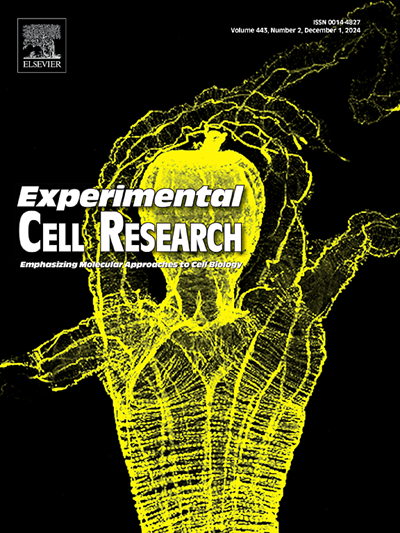GLUT1 maintains esophageal cancer stem cell-like characteristics by inhibiting autophagy-dependent ferroptosis via EGFR
IF 3.3
3区 生物学
Q3 CELL BIOLOGY
引用次数: 0
Abstract
Esophageal cancer, a highly malignant tumor with poor prognosis, is characterized by the presence of cancer stem cells (CSCs) that drive tumor initiation, metastasis, and recurrence. This study investigates the molecular mechanism by which glucose transporter 1 (GLUT1) maintains esophageal CSC-like properties through regulation of autophagy-dependent ferroptosis via epidermal growth factor receptor (EGFR). Using shRNA to knock down GLUT1 or EGFR and constructing a GLUT1 overexpression vector in KYSE520 cells, we employed western blotting, qRT-PCR, flow cytometry, sphere formation, Transwell assays, and xenograft models to assess stemness markers (NANOG, OCT4, SOX2), autophagic flux (LC3B, P62, Beclin1), and ferroptosis-related parameters (ROS, Fe2+, GSH, GPX4, COX2). Mechanistic analyses included co-immunoprecipitation to validate the GLUT1-EGFR interaction, chloroquine to inhibit autophagy, and cycloheximide/MG132 to evaluate EGFR protein stability. Results showed that GLUT1 depletion reduced CSC marker expression, increased ROS and Fe2+ levels, depleted GSH, and induced lipid peroxidation, sensitizing cells to ferroptosis while activating autophagy (elevated LC3 II/I, Beclin1; reduced P62); autophagy inhibition exacerbated cell death, indicating a protective role for autophagy in this context. GLUT1 directly bound to EGFR, stabilizing the receptor by blocking ubiquitin-proteasome-mediated degradation, whereas EGFR knockdown enhanced autophagic flux and reversed GLUT1-overexpression-induced ferroptosis resistance and stemness maintenance. In vivo, GLUT1 knockdown suppressed tumor growth and lung metastasis, and clinical samples revealed a positive correlation between GLUT1 and EGFR expression, linked to advanced TNM stages and poor survival. Collectively, these findings demonstrate that GLUT1 preserves esophageal CSC-like characteristics by stabilizing EGFR to inhibit autophagy-dependent ferroptosis, highlighting targeting GLUT1 as a potential therapeutic strategy to eliminate CSCs and combat esophageal cancer progression.
GLUT1通过EGFR抑制自噬依赖性铁下垂维持食管癌干细胞样特征。
食管癌是一种预后不良的高度恶性肿瘤,其特点是肿瘤干细胞(cancer stem cells, CSCs)的存在驱动肿瘤的发生、转移和复发。本研究探讨了葡萄糖转运蛋白1 (GLUT1)通过表皮生长因子受体(EGFR)调控自噬依赖性铁凋亡维持食管csc样特性的分子机制。利用shRNA敲低GLUT1或EGFR,并在KYSE520细胞中构建GLUT1过表达载体,我们采用western blotting、qRT-PCR、流式细胞术、球形成、Transwell实验和异种移植模型来评估干细胞标志物(NANOG、OCT4、SOX2)、自噬通量(LC3B、P62、Beclin1)和凋亡相关参数(ROS、Fe2+、GSH、GPX4、COX2)。机制分析包括共免疫沉淀验证GLUT1-EGFR相互作用,氯喹抑制自噬,环己亚胺/MG132评估EGFR蛋白稳定性。结果显示,GLUT1缺失降低了CSC标志物的表达,增加了ROS和Fe2+水平,减少了GSH,诱导脂质过氧化,使细胞对铁死亡敏感,同时激活自噬(LC3 II/I升高,Beclin1;减少P62);自噬抑制加剧了细胞死亡,表明自噬在这种情况下具有保护作用。GLUT1直接与EGFR结合,通过阻断泛素蛋白酶体介导的降解来稳定受体,而EGFR敲低可增强自噬通量,逆转GLUT1过表达诱导的铁下垂抵抗和干性维持。在体内,GLUT1敲低抑制肿瘤生长和肺转移,临床样本显示GLUT1与EGFR表达呈正相关,与TNM晚期和生存率低有关。总之,这些研究结果表明,GLUT1通过稳定EGFR抑制自噬依赖性铁下垂来保持食管csc样特征,强调靶向GLUT1是消除csc和对抗食管癌进展的潜在治疗策略。
本文章由计算机程序翻译,如有差异,请以英文原文为准。
求助全文
约1分钟内获得全文
求助全文
来源期刊

Experimental cell research
医学-细胞生物学
CiteScore
7.20
自引率
0.00%
发文量
295
审稿时长
30 days
期刊介绍:
Our scope includes but is not limited to areas such as: Chromosome biology; Chromatin and epigenetics; DNA repair; Gene regulation; Nuclear import-export; RNA processing; Non-coding RNAs; Organelle biology; The cytoskeleton; Intracellular trafficking; Cell-cell and cell-matrix interactions; Cell motility and migration; Cell proliferation; Cellular differentiation; Signal transduction; Programmed cell death.
 求助内容:
求助内容: 应助结果提醒方式:
应助结果提醒方式:


